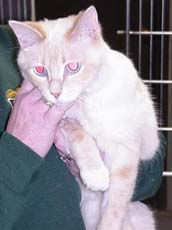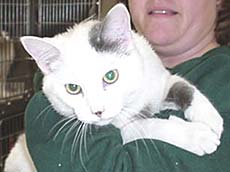|
Features,
Animals
for Adoption,
Out
and About,
Other
travel news
|
|
Features
|
|
|
From the Illinois
Nurserymenís Association
Gardening Tips
April 2001
[APRIL
7, 2001]
Spring
has sprung, and now itís time to get your garden growing! Your local garden
centers will be coming alive with new products and information. The ICN Pro at
your local garden center will be anxiously awaiting your visit. He or she will
be able to answer your gardening questions and offer great advice.
|
|
There
are many things to do in your yard and garden in April. Following is
a short list of reminders.
-
Your
bulbs will continue to pop up and bloom. After they bloom be
sure to let their foliage ripen. That means you should allow the
foliage to die away on its own ó do not cut it back, tie it in
knots or otherwise destroy it. The foliage provides food for the
bulb, allowing it to grow and produce a flower the next season.
Once the foliage is completely brown, then it is time to cut it
back.
-
If
you are planning to install a new garden area or revamp an old
one, now is the time to do your bed preparation. If your soil is
poor, you should work an organic material (like mushroom
compost) into the soil when your do your bed preparation.
Application rates can vary depending on your soil type. An ICN
Pro at your local garden center will be able to help you
determine the amount your soil requires.
-
Perennials
will be arriving at your local garden center throughout the
month of April. Most of the perennials can be planted beginning
in April. Some perennials will tolerate cold better than others,
so to be absolutely certain ask the ICN Pro at your garden
center. Visit your local garden center frequently to see what
new perennials are in bloom. There will be something new almost
every week.

-
When
planting your annuals you need to think about the danger of
frost. Some annuals, like Johnny-jump-ups and pansies, can
tolerate a frost; others will not. Most annual planting should
be delayed until the frost-free date for your area passes. Your
ICN Pro will be able to tell you which ones you can plant now
and which ones you should wait on.
[to top of second column in this
article]
|

-
April
is a good month to sow your grass seed. Remember that you CANNOT
apply crabgrass preventer on your newly seeded areas!
-
Toward
the end of April you can spray the weeds that are growing in
your yard. It is a good idea to wait until the end of April to
spray weeds because by then most of the weeds are actively
growing.
-
Fruit
trees need to be sprayed before they bloom and then again after
they bloom. It is very important that you DO NOT spray while the
tree is in bloom. Spraying at this stage will kill the
pollinating insects, including honeybees, and severely reduce
your fruit production.
-
April
is the month to treat for peach leaf curl. If you have cherry,
apricot or other Prunus species, they need to be sprayed before
the buds break. Products that are effective are lime sulfur and
captan. If you have questions, an ICN Pro at your local garden
center will be able to help you.
For
more gardening information, visit your ICN Pros at your local garden
center! While youíre there, be sure to check out the spring
blooming perennials, shrubs and trees! Weíll be back next month
for Mayís Gardening Tips.
["Gardening
Tips" is provided monthly
by the Illinois Nurserymenís Association,
1717 S. Fifth St. in Springfield.]
|
|
ILLINI
BANK
2201
Woodlawn Rd. in Lincoln
1-888-455-4641 or 735-5400
Ask for Terry Lock or Sharon Awe
Mortgage
Refinancing
Ag Lines of Credit
Low Auto Rates
Free Checking - Debit Card
Money Market Index Account |
Claire's
Needleworks
and Frame Shop
"We
Frame It All"
On the square
217-732-8811
M-F 10-5 Sat 10-4
cmstitches@aol.com |
Tell
a friend about
Lincoln Daily
News.com |
|
|
|
Parenting
Again
Free newsletter for
grandparents raising grandchildren
[MARCH
24, 2001]
The
number of grandparents who are raising their grandchildren is on the rise. In
Illinois, about 70,000 children are raised in homes where a grandparent is the
sole caregiver.
|
|
"Grandparents
who have become parents again come from all walks of life and from
all cultural and economic groups," explains Molly Hofer, family
life educator with University of Illinois Extension. "They
often feel overwhelmed and alone when they take on the parenting
role."
In
an effort to address concerns that grandparents face, U of I
Extension is offering a free newsletter, Parenting Again. This
monthly newsletter offers practical tips on issues like finding
support groups and resources, helping grandchildren succeed in
school, taking care of your own health, effective discipline, and
unique challenges for second-time parents.
[to top of second column in this
article]
|

"The
newsletter also covers seasonal topics like summer activities,
holiday gift-giving and school enrollment," says Hofer.
To
find out more about the Parenting Again newsletter, contact the U of
I Extension office in Logan County. You can subscribe by phone,
(217) 732-8289; fax, (217) 735-5837; or e-mail, lock@mail.aces.uiuc.edu.
[University
of Illinois Extension]
|
|
|
Planning
the trip
Travelers get info,
deals online and visit their travel agents for a personal touch
[MARCH
24, 2001]
The
widespread use of the Internet for online travel arrangements may have had an
impact on most local travel agenciesí business, but customers still seem to
prefer a personal touch.
|
|
Travel
agent Becky Grapes of World Travel in Springfield said her customers
may shop around for travel deals on their personal computers, but
they come back to her for booking and purchases.
"People
are using the Internet, but it doesnít seem to be affecting us.
They like the personal service and know that if they have a problem,
they have someone to come back and talk to. On the Internet, there
is no one to talk to. People are very leery of that," she said.
"Customers are still going to use a travel agency in a lot of
ways."
Technology
has definitely changed the way people plan their vacations, with
everything from electronic tickets, online price wars and an
abundance of websites devoted to all aspects of the travel industry.
But
despite the wealth of information now available which allows
consumers to compare prices and find the best deal, local travel
agents are hearing complaints from dissatisfied customers who used
the Internet to make their own travel plans. Most of those former
customers have returned to a brick-and-mortar travel agency after
going it alone. The unique aspects that make up a wireless world of
travel seem to be the same things driving consumers back to their
local travel agents.
"We
hear that once or twice a day ó complaints from people booking
travel plans through websites, and then customers not getting what
they were promised. Thereís no recourse," Grapes added.
Customers
find more advantages dealing with a travel agent than through the
Internet, she said.
"Itís (Internet) very restrictive. Often tickets purchased
online cannot be exchanged or
returned. With us, if there is a cancellation, they still have
credit. That still means a lot to people," she said.
"Customers use the Internet for research and find out what they
want, and then call us. They feel more comfortable by having a
person to talk to and an actual ticket."
Despite
the downfalls, however, shopping for travel online has proved useful
not only for
customers but also for the travel industry. Grapes uses the Internet
for research so she can offer her customers more information. She
says it has worked to her advantage, because customers really
appreciate the fact she can offer them additional information and
point them to websites for virtual tours, photos and details she
once had to look through brochures or make numerous phone calls to
obtain.
She
said most agents donít use the Internet for airline fares, which
are booked through the airlines, but do utilize it to book hotels,
packages and tours.
"Itís
definitely helped us with research. Itís nice to be able to tell
someone what the website is at the resort they are looking at. Some
are very informative, with pictures and virtual tours," she
added.
A
survey of travel agencies conducted by Travel Weekly found about 78
percent of U.S.
agencies now can access the Internet on-site, and indications are
that number will continue to grow.
Jean
Martin, manager of Bergnerís Travel in White Oaks Mall, said her
business has decreased about 10 percent due to people making travel
plans online. Most of those customers, however, have returned to her
agency after bad experiences and dissatisfaction. "They know
they can come back [to us] if thereís a problem," she said,
which often isnít the case when making travel plans online.
Martin
said sheís noticed a decrease in the volume of business during the
past few years,
with many former customers saying they now use the Internet to make
travel plans.
However,
many of those customers have been unhappy. "They thought they
were getting one thing, and they were getting something else,"
she said.
[to top of second column in this
article]
|
According
to Forrester Research, online travel sales are predicted to reach an
estimated
$7.4 billion in 2001.
One
of the biggest concerns for travel agents trying to compete with
this increase in online sales is the growing number of suppliers
enticing travelers with offers that can be found only on Internet
sites or in weekly e-mails.
Grapes
acknowledges that itís hard to compete with those offers but isnít
worried that the computer age will replace the hands-on art of doing
business with a travel agent.
Patricia
Groves, owner of Moniqueís Travel in Springfield, agrees. "At
first, maybe the Internet had a negative impact [on our business].
But now what weíre seeing is that consumers do research and then
come to us," she said. "The Internet is a powerful tool
that sometimes makes it easier, but sometimes youíre [travel
agent] just an order-taker."
Groves
said about 85 percent of people who do research on the Internet then
call her office to buy tickets, if she can match the prices.
"More people are doing that. A lot of tour companies and
vacation-package companies offer information on the Internet. Then
customers ask me about what theyíve seen and come in and book with
us," she said.
"I
think itís confusing. Recently, an elderly woman purchased a
ticket on the Internet.
When she got the ticket ó a non-refundable ó her sister in
Florida who she was going to visit passed away. She came in and
asked me to fix it," she said. "Itís the personal touch
people are wanting. If they run into a problem, sometimes the
Internet company is hard to get a hold of.
"Every
time new technology comes out, doomsayers say travel agencies are
going to be
out of business. But we adapted to the computer in the early í80s
when computer airline
registrations came out. Now weíve adapted to the Internet,"
she said.
Indeed,
most local travel agents feel that information alone is not enough
to sell travel.
National statistics support their theory that consumers feel the
Internet simply canít match the range of personalized services a
professional can offer.

According
to a study by the American Society of Travel Agents (ASTA) ó the
world's largest and most influential travel trade association ó
many consumers feel the Internet canít give them many things a
travel agent can: firsthand experience; personalized service; expert
advice; professional assistance with problems such as flight
cancellations and missed connections; convenient one-stop shopping;
follow-up service; ability to reissue, void or change tickets; human
interaction; and special requests like wheelchairs, pet care and
dietary needs.
Complaints
mentioned by consumers in the study who made their own travel plans
included not understanding the restrictions, being unable to get
advertised fair or quoted prices, concerns about reputation of a
company, paying more than necessary, and feeling the process was
time-consuming and confusing. Booking the wrong date or time, having
their credit card denied but not being notified, and having no
assistance with changes in their tickets were also common
complaints.
Groves
said her agency charges a service fee, to make up for a 50 percent
commission cut
made five years ago by the airline industry, but feels itís
justified because "we do feel like we do a service. We do
research, obtain seats for customers, help with problems or changes.
We feel we bring a value to what we do, but the service fee has
nothing to do with decreased business due to Internet
competition," she said. "Thereís too many things that
are complicated about travel. People still need us."
[Penny
Zimmerman-Wills]
|
|
It's
Tax Time
Come
see the tax professionals at
Meier
Accounting
and
Tax Service
Dale
Meier, Enrolled Agent
519
Pulaski, Lincoln
217-735-2030
|
Tell
a friend about
Lincoln
Daily News.com
|
Blue
Dog Inn
111 S. Sangamon
217-735-1743
Open
for Lunch Mon.-Sat.
Open for Dinner Tues.-Sat.
Click
here to view our
menu and gift items
|
|
|
|
Animals
for Adoption
|
|
These animals and
more are available to good homes from the Logan County Animal
Control at 1515 N. Kickapoo, phone 735-3232.
Fees for animal
adoption: dogs, $60/male, $65/female; cats, $35/male, $44/female.
The fees include neutering and spaying.
Logan County Animal
Control's hours of operation:
Sunday Ė closed
Monday Ė
8 a.m. - 5 p.m.
Tuesday Ė
8 a.m. - 5 p.m.
Wednesday Ė
8 a.m. - 5 p.m.
Thursday Ė
8 a.m. - 5 p.m.
Friday Ė
8 a.m. - 3 p.m.
Saturday Ė
closed
Warden: Sheila Farmer
Assistant: Michelle Mote
In-house veterinarian: Dr. Lester Thompson
|
DOGS
Big to
little, most these dogs will make wonderful lifelong companions when
you take them home and provide solid, steady training, grooming and
general care. Get educated about what you choose. If you give them
the time and care they need, you will be rewarded with much more
than you gave them. They are entertaining, fun, comforting, and will
lift you up for days on end.
Be prepared to take the necessary time when you bring home a
puppy, kitten, dog, cat or any other pet, and you will be blessed.
[Logan
County Animal Control is thankful for pet supplies donated by
individuals and Wal-Mart.]
|

Molly,
a very loving pit bull mix puppy,
is 3 months old.
|

There
are three of these adorable puppies:
two brown and one black.
They are about 3 months old, very sweet and would make
good farm dogs.
|
|
|

This
female border collie is about 1 year old.
She is very sweet and would be a good farm dog.
|

This
friendly black mix is 1 or 2 years old, with a
good
disposition. He
would make a good farm dog.
|
|
|
|
|
Ten reasons to adopt a
shelter dog
1.
I'll bring out your
playful side!
2.
I'll lend an ear to
your troubles.
3.
I'll keep you
fit and trim.
4.
We'll look out for each other.
5.
We'll sniff
out fun together!
6.
I'll keep you
right on schedule.
7.
I'll love you
with all my heart.
8.
We'll have a
tail-waggin' good time!
9.
We'll snuggle
on a quiet evening.
10.
We'll be
best friends always.
|
|
It's
Tax Time
Come
see the tax professionals at
Meier
Accounting
and
Tax Service
Dale
Meier, Enrolled Agent
519
Pulaski, Lincoln
217-735-2030 |
The
Mustard Moon
1314
Fifth Street
Gifts ~
Dolls
Infant Clothes
Mention
ad
for 2 FREE votives |
Blue
Dog Inn
111 S. Sangamon
217-735-1743
Open
for Lunch Mon.-Sat.
Open for Dinner Tues.-Sat.
Click
here to view our
menu and gift items |
|
|
|
CATS
[Logan
County Animal Control is thankful for pet supplies donated by
individuals and Wal-Mart.]
|
| In
the cat section there are a number of wonderful cats to
choose from. There are a variety of colors and sizes. |
|

Purdy is a 1-year-old male Siamese-Himalayan
mix, light orange and white. He is neutered, housebroken and
good with kids.
|

Baby
is a female, long-haired, gray calico.
She is 1 year old.
|

This
female calico is good cat.
She is 1 year old and friendly.
|

Callie
is a friendly, gray calico.
She is about 1 year old.
|

This
gray and white cat is friendly
and would made a good farm cat.
|
|
|
|
|
|
|
|
|

|
|
Part
2
A taste
of New England just off Route 66
It's maple sirup time at Funks Grove
By
Penny Zimmerman-Wills
[MARCH
20, 2001]
Tucked
amid a grove of towering timber just off a quiet stretch of old
Route 66 near Bloomington sits a slice of New England. At the end of
a curved dirt lane is a modest shingled home, a low-slung brown sap
house spouting large clouds of steam, and rows and rows of trees
with aluminum buckets attached to their trunks. Ancient gnarled
oaks, slender saplings and majestic maples give the place an almost
mystical feeling. A small red building with simple, black painted
letters spelling out Funks Grove is nestled among the virgin timber
and provides a wonderful burst of color in what is otherwise a sea
of gray bark.
|
|
[click here for Part
1]
"Funks
Grove is actually a township. There once was a town with a post
office and a few businesses, but as Bloomington grew, the town dried
up. Funks Grove now is a church, cemetery and a Sugar Grove Nature
Center, which gives visitors a chance to see how the land once
looked when settlers arrived," Mike Funk said.
The
area once supported six syrup camps, but only his family has managed
to stay in the business, Funk said.
The
cold weather crop season only lasts four to six weeks, beginning in
February and March, and during that time the Funks gather between
40,000 and 60,000 gallons of maple sugar from the stand of trees,
which yields between 800 and 1,200 gallons of syrup.
The
shop sells bottles and bottles of the stuff until they run out,
which is usually about the
beginning of August.
The
brown sap house is where the action takes place and where the watery
substance
collected from the trees is turned into syrup. Customers flow in and
out of the adjoining
gift shop, which offers light syrup and dark syrup, in jars and jugs
and log-cabin cans. You can buy maple candy and maple cream or Funks
Grove Honey. There are also nature books, cookbooks, T-shirts
("Just naturally sweet") and plenty of Route 66
memorabilia, plus the romance and children's novels written by
Funk's sister.
Funk,
who also has a part-time job and farms, said he usually takes a
vacation from his other jobs during this time of year to manage the
business.

Mother
Nature can actually be given the credit for knowing when itís time
to start the process. In the early spring, a freezing and thawing
cycle is required to generate the flow of sap, according to Funk. A
tree must be 40 years old and 10 inches in diameter to support one
tap. Holes up to 2 inches deep are drilled into the trees with a
power drill. Metal spouts are hammered into the trees and metal
buckets are hung on the majority
of the 4,000 taps drilled annually. The rest are connected to a more
modern pipeline tubing system. When warm thawing temperatures follow
a hard freeze, the sap begins to run. Under ideal conditions, a
150-quart sap bucket can fill in 10 hours.
[to top of second
column in this section]
|



Each
crew member totes two five-gallon gathering pails and moves from
tree to tree, pouring the sap from their buckets into the pails.
When the pails are full, they are poured into a tank pulled through
the woods by a tractor. The collected sap is stored in an
underground cistern to keep it from getting too cold or warm.
The
process of evaporation makes 50 gallons of sap become one gallon of
syrup. The liquid is pumped from the cistern into the evaporation
tank, which is a series of connected metal pans. As the level of sap
in the pans decreases through the evaporation, more sap is metered
into the pans by a flat device, and the temperature must be raised
six degrees. After being drawn off the evaporation tank, the liquid
is finished in the gas-fired finishing pan, where the liquid is
raised another degree, pressure-filtered and then bottled while itís
hot. The entire process from cistern to bottling tank can be done in
less than three hours, according to Funk.
After
dealing with sticky fingers several months of the year, how does
Funk actually use the stuff? "Mostly in the traditional way, on
pancakes and waffles, hot cereals or biscuits. Itís also good on
ice cream," he said. And most customers donít hesitate to
indulge despite a trend toward healthier, light eating these days.
"Itís
a natural sugar, itís not processed sugar. You can use it in
baking as a sugar replacement. We say thereís no fat, just all
calories," Funk said with a smile.
When
the buds on the maples begin to swell, it signals the end of the
season. Buckets and
bags come down, spouts are pulled off and the camp receives a good
spring cleaning. But
even after the sign at the end of the road says "Closed for the
Season," customers still
wind their way up the wooded lane looking for a taste of New
England.
[Penny
Zimmerman-Wills]
|
|
ILLINI
BANK
2201
Woodlawn Rd. in Lincoln
1-888-455-4641 or 735-5400
Ask for Terry Lock or Sharon Awe
Mortgage
Refinancing
Ag Lines of Credit
Low Auto Rates
Free Checking - Debit Card
Money Market Index Account |
Claire's
Needleworks
and Frame Shop
"We
Frame It All"
On the square
217-732-8811
M-F 10-5 Sat 10-4
cmstitches@aol.com |
Tell
a friend about
Lincoln Daily
News.com |
|
|
|
Part
1
A taste
of New England just off Route 66
It's maple sirup time at Funks Grove
By
Penny Zimmerman-Wills
[MARCH
19, 2001]
Tucked
amid a grove of towering timber just off a quiet stretch of old
Route 66 near Bloomington sits a slice of New England. At the end of
a curved dirt lane is a modest shingled home, a low-slung brown sap
house spouting large clouds of steam, and rows and rows of trees
with aluminum buckets attached to their trunks. Ancient gnarled
oaks, slender saplings and majestic maples give the place an almost
mystical feeling. A small red building with simple, black painted
letters spelling out Funks Grove is nestled among the virgin timber
and provides a wonderful burst of color in what is otherwise a sea
of gray bark.
|
|
The
scene could easily be found in the eastern region of the country,
but itís here at Funks Grove Sirup Camp ("sirup" with an
"i" is the preferred spelling at Funks Grove). This tiny
spot in central Illinois is where the Funk family has been making
the sweet liquid since the early 1920s. On a recent sunny winter
day, three bus loads of senior citizens and school children toured
the site, and all seemed fascinated with how maple syrup is made.
Young and old alike squealed with delight as they tested samples and
eagerly purchased more to take home.
Mike
and Debby Funk, who now operate the business, took turns giving
tours of the operation and explaining the process from the beginning
stages in the woods to the end result, which appears in glass
bottles in the gift shop. Pure maple syrup is produced commercially
at only a handful of places in the Midwest, which explains part of
the appeal of the place. The other reason is that because of its
location on a historic road itís often found by visitors who might
not otherwise know about it.
"We
get a lot of visitors from Route 66," Debby Funk said.
"During the summer months we get groups on motorcycles or
antique cars, doing the Route 66 trip from Chicago to California. Itís
fun."

In
fact, there are so many visitors from so many places, she keeps a
world map in the gift shop and has customers mark the country or
city where theyíre from. Some people, from as far away as Brazil,
Australia, Africa, Japan and Germany, have drawn their home on the
back of the map.
The
business, which is listed on the Route 66 Hall of Fame and was
designated a Registered Natural Landmark by the National Park
Service, has become a common stop for many repeat customers who canít
get enough of the sweet, sticky stuff.
"We
start getting phone calls in January and people say they are running
out of syrup and need more," Mike Funk said. "We still get
people who remember we were here and always wanted to stop by. Once
the nostalgia associated with Route 66 hit, people started traveling
from Chicago to Los Angeles, and they stopped in out of
curiosity."
I
must admit, I was one of those people who had always noted the large
billboard advertising Funks Grove while traveling north on I-55 but
had never bothered to stop. Iím so glad I finally did, because the
hospitality of the Funk family is as welcoming and soothing on a
crisp winter day as the warm syrup they produce.

[to top of second
column in this section]
|



The
timber where the camp is located is actually owned by the trust fund
of Hazel Funk Holmes, a nature-loving relative who intended a walk
though the camp to be an educational experience. By the terms of her
will, her woodlands will be preserved and maple syrup will continue
to be produced at Funks Grove as long as its feasible, Funk said.
It
all started when great-grandfather Isaac Funk, the pioneer founder
of what was later known as Funks Grove, settled in 1824 in an area
rich in maple trees and discovered the art of making maple syrup and
maple sugar, which during that time was the only way to get readily
available sweetener. Isaacís grandson Arthur opened the first
commercial syrup camp at Funks Grove in 1891, selling the sweet
stuff for $1 a gallon as a luxury item. Arthurís brother Lawrence
later ran the operation and passed it on to his son, who is Mike
Funkís father.
Mikeís
father, Stephen, 76, and his mother, Glaida, 74, took over the camp
in 1948. Although they officially retired about 12 years ago, theyíre
still on hand most days, helping out at the business. Itís hard to
get away, not only because they enjoy it but also because they live
in the shingled house just yards away from the sap house and the
center of activity. "Itís a part of their life, it always
will be," Funk said.

Indeed,
Funk has passed the family tradition on to his three children. His
two daughters and son grew up helping out in the familyís seasonal
business, and his daughters liked to make maple candy sold in the
gift shop as a way to earn extra spending money.
It
was made possible by Isaacís granddaughter Hazel, whose trust
provides the forest and capital needed for producing syrup. She was
also was the person who insisted "sirup" was the preferred
spelling. Noting that the U.S. Agriculture Department uses the
spelling, the Funks decided to stick with it out of respect for
Holmes.
"Hazel
Funk Holmes had 160 acres of timber that we operate on and also some
farm ground. We also rent trees from other trusts, so there are
probably 500 or 600 acres altogether," Funk said.
(To
be continued)
[Penny
Zimmerman-Wills]
[click
here for Part 2]
|
|
It's
Tax Time
Come
see the tax professionals at
Meier
Accounting
and
Tax Service
Dale
Meier, Enrolled Agent
519
Pulaski, Lincoln
217-735-2030 |
Tell
a friend about
Lincoln Daily
News.com |
Blue
Dog Inn
111 S. Sangamon
217-735-1743
Open
for Lunch Mon.-Sat.
Open for Dinner Tues.-Sat.
Click
here to view our
menu and gift items |
|
|
Back
to top |
News
| Sports
| Business
| Rural
Review | Teaching
& Learning | Home
and Family | Obituaries
Community | Perspectives | Law
& Courts | Leisure Time | Spiritual
Life | Health
& Fitness | Letters
to the Editor
|
|

